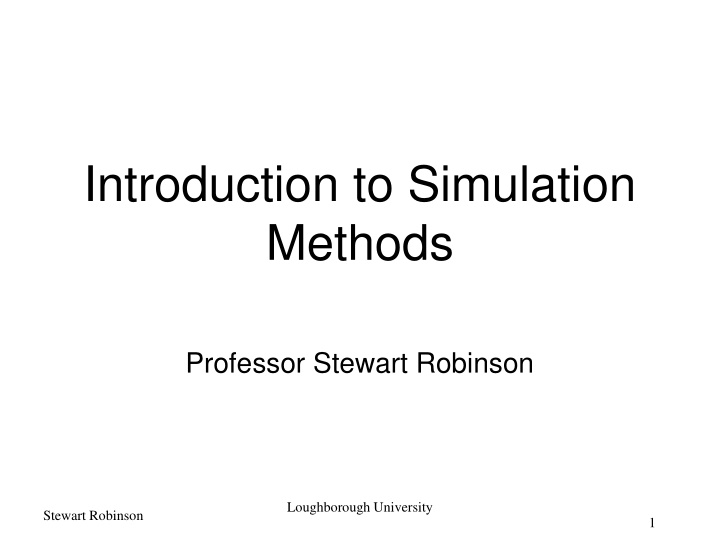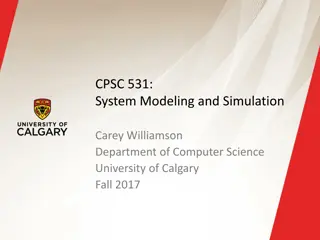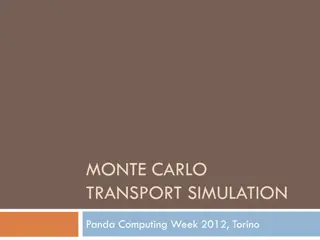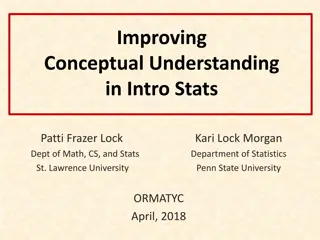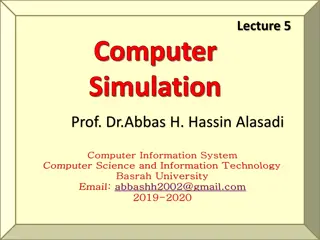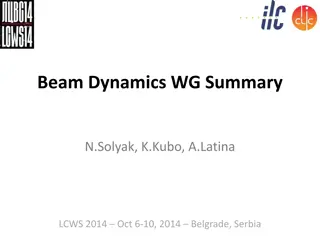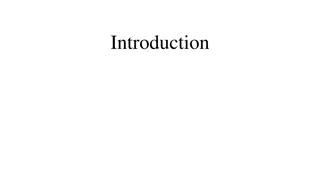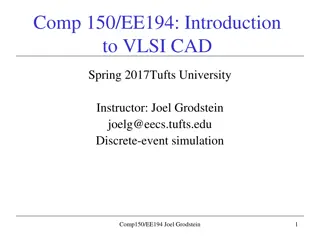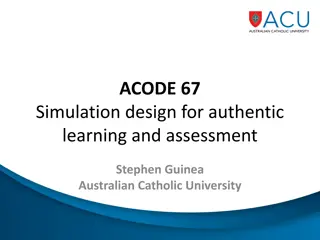Introduction to Simulation Methods by Professor Stewart Robinson
This content delves into the world of simulation methods as presented by Professor Stewart Robinson from Loughborough University. It covers the basics of simulation, its importance, different approaches, and real-world examples showcasing its practical applications in industries like aviation and automotive. Through images and text excerpts, the audience gets insights into how simulation aids decision-making processes by providing a simplified imitation of complex systems for analysis and prediction.
Download Presentation

Please find below an Image/Link to download the presentation.
The content on the website is provided AS IS for your information and personal use only. It may not be sold, licensed, or shared on other websites without obtaining consent from the author.If you encounter any issues during the download, it is possible that the publisher has removed the file from their server.
You are allowed to download the files provided on this website for personal or commercial use, subject to the condition that they are used lawfully. All files are the property of their respective owners.
The content on the website is provided AS IS for your information and personal use only. It may not be sold, licensed, or shared on other websites without obtaining consent from the author.
E N D
Presentation Transcript
Introduction to Simulation Methods Professor Stewart Robinson Loughborough University Stewart Robinson 1
Session Outline What is simulation? Why use simulation? Four simulation approaches Loughborough University Stewart Robinson 2
How did British Airways Decide on the Design of Terminal 5? How many check- in desks? How many departure gates? Flight schedule capacity Configuration of security screening Size of passport control area? Workforce rosters Design of baggage handling system Loughborough University Stewart Robinson 3
Terminal 5 Simulation Source: Beck, A. (2011). Journal of Simulation 5, 69 76 Loughborough University Stewart Robinson 4
What is Simulation? Simulation is: an imitation of a system Simulation video Experimentation with a simplified imitation (on a computer) of a ... system as it progresses through time, for the purpose of better understanding and/or improving that system. (Robinson, 2014) Loughborough University Stewart Robinson 5
What is Simulation? Inputs Outputs Simulation model Experimentation A simulation model enables a manager to experiment with alternative courses of action, the simulation providing predictions about the likely outcome. As a result, the manager obtains a better understanding of reality and is able to identify good courses of action. Loughborough University Stewart Robinson 6
Examples of Simulation Ford Motor Company. Simulation was widely used to aid the planning and design of their Zetec engine plants in South Wales. These represented an investment of $750m. The simulations helped improve output by around 30%. Loughborough University Stewart Robinson 7
Examples of Simulation Nuclear Industry Emptying a waste pond and processing the waste to make it safe. Achievement of waste removal to a specified timeline. Loughborough University Stewart Robinson 8
Examples of Simulation Outpatients Department Rebuild: investigation of number of consulting rooms required. Loughborough University Stewart Robinson 9
Why Use Simulation? Because systems are subject to variability, are interconnected and complex. 1. Variability: Predictable variability e.g. shift changeovers, preventative maintenance Unpredictable variability e.g. customer arrivals, breakdown Loughborough University Stewart Robinson 10
Why Use Simulation? 2. Interconnectedness Variability does not occur in isolation, but is connected to other sources of variability. Customer arrivals Service 1 Service 2 Service 3 Time: 10 mins Time: 9 mins Time: 9 mins Time: 9 mins What is the mean time a customer spends in the system? Loughborough University Stewart Robinson 11
Why Use Simulation? 3. Complexity Combinatorial complexity: the number of combinations of system components that are possible. 2 interconnections 20 interconnections Combinatorial complexity is related to the size of a system. Loughborough University Stewart Robinson 12
Why Use Simulation? 3. Complexity Dynamic complexity: related to the interaction of components in a system over time. It is normally associated with feedback e.g. a kanban system: Information Parts M1 B1 It is not necessarily related to the size of a system. Loughborough University Stewart Robinson 13
Simulation Approaches Monte Carlo Simulation (not strictly business dynamics) f (a, b, c) Random sampling process (hence Monte Carlo ) Not always dynamic (time-based) models Typical used in finance applications for portfolio management Loughborough University Stewart Robinson 14
Simulation Approaches Discrete-Event Simulation World represented as Queues and Activities Variable time step to represent changes in state of the system Used for modelling queuing systems e.g. airports, banks, manufacturing plant, call centres, ports, computer systems,... Loughborough University Stewart Robinson 15
Simulation Approaches Continuous Simulation (e.g. system dynamics) Population Birth rate Death rate Average lifetime Fertility World represented by Stocks and Flows Constant (small) time step ( t) to approximate continuous time Typical used in business strategy/policy and more general continuous simulation in science and engineering Loughborough University Stewart Robinson 16
Simulation Approaches Agent Based Simulation Boids simulation World represented by (intelligent) interacting agents Constant time step ( t) but can be discrete-event Used for exploring emergent behaviour in organisations as well as other contexts: evacuation, traffic flow, stock markets, diffusion of innovation, spread of infectious diseases Loughborough University Stewart Robinson 17
Reading Discrete-Event Simulation Robinson, S. (2014). Simulation: The Practice of Model Development and Use, 2nd ed. Palgrave, London. Law, A.M. (2014). Simulation Modeling and Analysis, 5th ed. McGraw-Hill, New York. System Dynamics Morecroft, J. (2007). Strategic Modelling and Business Dynamics: A Feedback Systems Approach. Wiley, Chichester. Sterman, J.D. (2000). Business Dynamics: Systems Thinking and Modeling for a Complex World. McGraw-Hill, New York. Loughborough University Stewart Robinson 18
Reading Agent Based Modelling Robertson, D.A. and Caldart, A.A. (2009). The Dynamics of Strategy: Mastering Strategic Landscapes of the Firm. Oxford University Press. Axelrod, R. (1997). The Complexity of Cooperation: Agent-Based Models of Competition and Collaboration. Princeton University Press. North, M.J. and Macal, C.M. (2007). Managing Business Complexity: Discovering Strategic Solutions with Agent-Based Modeling and Simulation. Oxford University Press. Loughborough University Stewart Robinson 19
